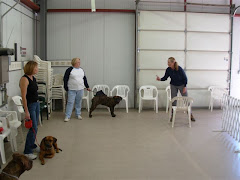
My sister keeps asking what kind of dog I'd recommend for her. She wants a fairly small but sturdy dog, an easy keeper, a non-yapper, a smart and trainable dog, a good companion with some real personality, and a fairly calm dog. Short hair would be good too.
I keep saying, "Get a Pug."
For years I've admired many a spunky Pug who came through my training classes. They are among the most teachable breeds I worked with. I've seen Pugs excel in obedience, agility and rally. Because they're so intelligent, they require owners who are more intelligent than they are. If they respect their owners, these dogs are willing to jump through hoops and scale walls for their people. They are built for laps, so they like to snuggle.
If they do NOT respect their owners, the Pugs will do as they please. They can be strong-willed, and sometimes downright obstinate, which means they need determined owners. Pugs appreciate consistency and routine. They generally get along well with cats and other dogs. They do well with children and are quite tolerant of them. They're honest (just look at that face!), generally confident and sensible. Occasionally they'll show some attitude toward other dogs, and they can surprise you with their tenacity. But for the most part, they're pretty easy going.
Pugs can have trouble in the heat, primarily because of their short noses which make it difficult for the dogs to cool themselves while breathing. They snort and wheeze when they're awake, and snore when they sleep. There's also a fairly high incidence of hip dysplasia, and LOTS of shedding, even though their hair is short.
Many first-time Pug owners are amazed at how well their dogs respond in training classes. Anyone who's ever worked with a performance dog would appreciate the responsiveness of this breed.


















No comments:
Post a Comment